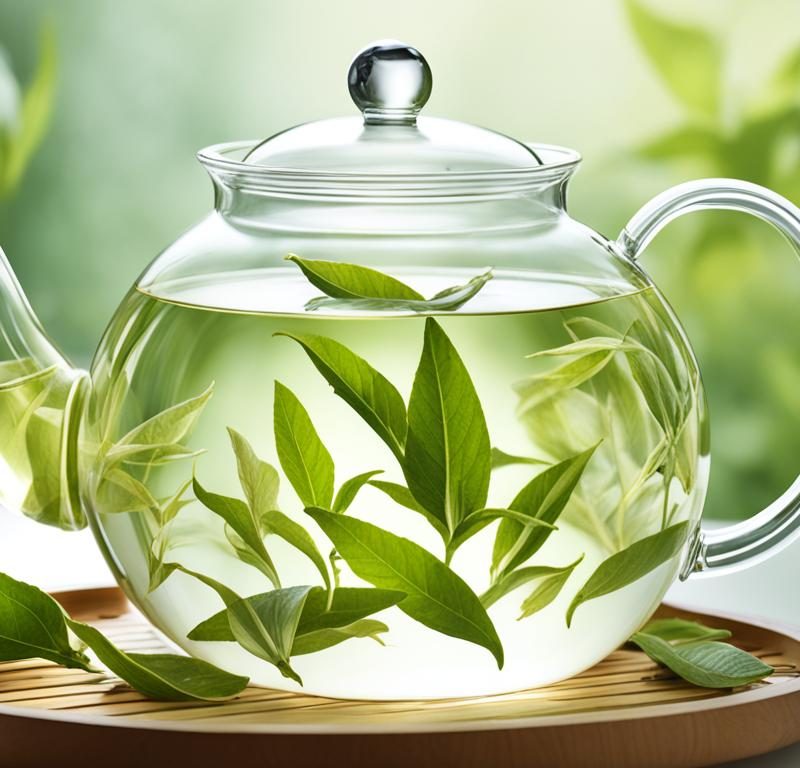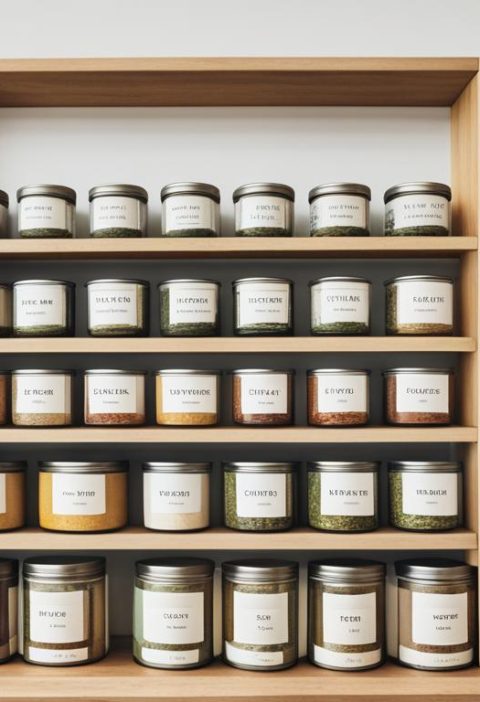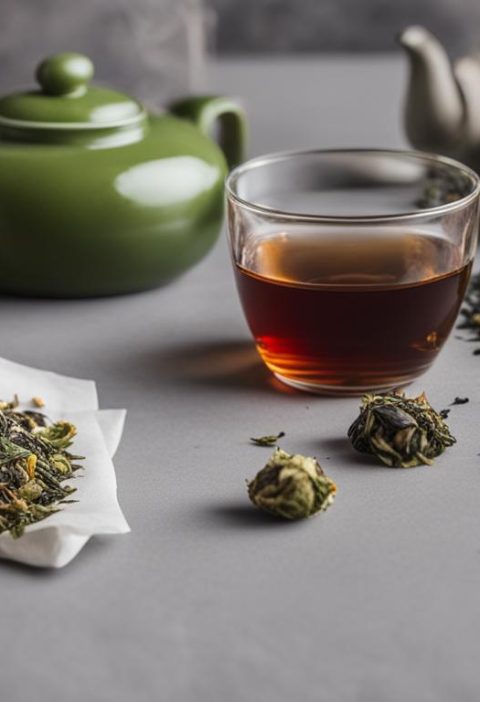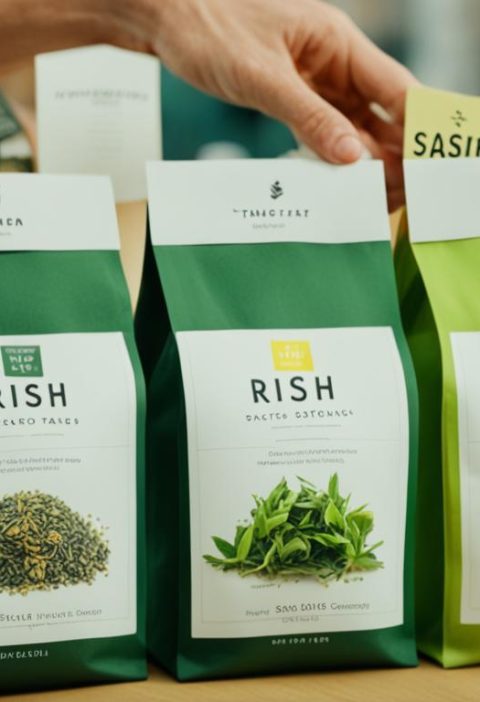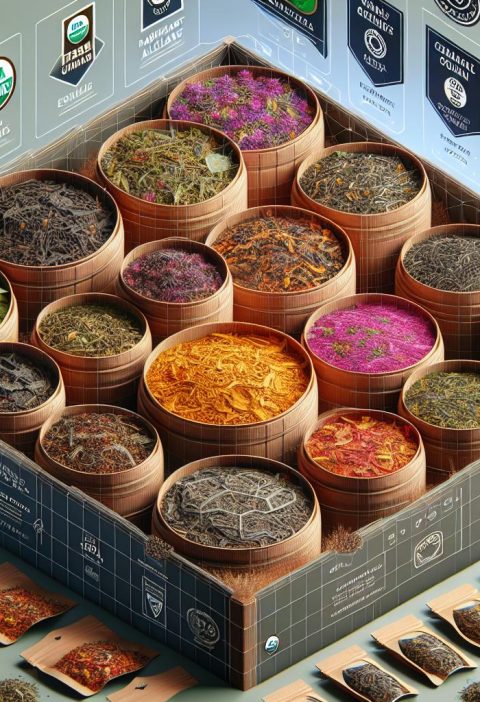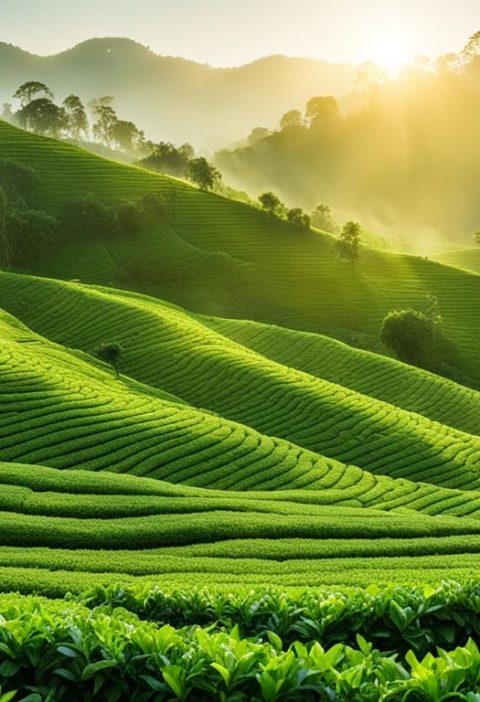Are you new to the world of white tea and looking for guidance on how to steep it properly? Look no further! In this beginner’s guide, we will walk you through the basics of steeping white tea, including water temperature, tea amount, and steeping time. As a white tea enthusiast and experienced tea drinker, I am excited to share my knowledge and expertise with you. By following these simple tips and techniques, you’ll be able to brew a perfect cup of white tea and savor its delicate flavors. Let’s get started!
White Tea Brewing Basics: Steeping Tips for Beginners
- Choose high-quality white tea leaves, preferably whole leaf tea, for the best flavor.
- Use a small pot or teapot that allows for the expansion of tea leaves during steeping.
- Heat the water to an ideal temperature of 180 to 185°F (82 to 85°C) to avoid scorching the delicate tea leaves.
- Use at least 2 tablespoons of tea per 8 ounces of water to ensure a flavorful infusion.
- Steep white tea for 4 to 7 minutes, adjusting the time based on your taste preferences.
- Experiment with different types of white tea to discover your preferred flavor profiles.
Key Takeaways:
- White tea is known for its delicately rich flavor and abundance of natural antioxidants.
- The ideal water temperature for steeping white tea is around 180 to 185°F.
- Use at least 2 tablespoons of white tea per 8 ounces of water for a flavorful infusion.
- Steeping time ranges from 4 to 7 minutes, depending on the type of white tea.
- White tea offers a range of flavors, from buttery and sweet to fruity and floral.
What is White Tea?
White tea is a type of tea that undergoes light oxidation and does not undergo fermentation or roasting processes like other teas. It gets its name from the pearly white hairs on the buds of the tea plant. White tea is mainly produced in China’s Fujian province, but it is also grown in India and Japan.
White tea is known for its subtlety of flavor and the delicate processing methods involved in its production. It offers a unique and nuanced taste profile, ranging from floral and fruity to buttery and sweet. One of the key characteristics of white tea is its high concentration of natural antioxidants, which makes it a popular choice among tea enthusiasts.
White tea is characterized by its delicate flavor and smooth, mellow taste. The leaves are harvested when they are still young, within the first three days of sprouting, and are handled with great care during processing to preserve their natural flavors. This gentle processing method allows the subtleties of the tea to shine through, resulting in a refreshing and nuanced cup.
In addition to its flavor, white tea is also valued for its high concentration of natural antioxidants. These antioxidants, such as polyphenols, help to protect the body against harmful free radicals and promote overall health and well-being. White tea also has lower caffeine levels compared to other teas, making it a suitable choice for those looking for a more mild and soothing tea experience.
Overall, white tea offers a unique and enjoyable tea-drinking experience, combining the subtlety of flavor with the health benefits of natural antioxidants.
Types of White Tea
When it comes to white tea, there are several types to explore, each offering its own unique flavor profile. Whether you prefer a delicate and sweet taste or a slightly stronger flavor, there is a white tea variety that is sure to delight your palate. Let’s take a look at some of the most popular types of white tea:
Silver Needle
Silver Needle is the most famous type of white tea, renowned for its exquisite taste and appearance. It is made solely from the tender, unopened spring buds of the tea plant. The name “Silver Needle” comes from the fine silver-white hairs that cover the tea buds, giving them a velvety texture. This delicate tea offers a subtly sweet flavor with floral undertones.
White Peony
White Peony, also known as Bai Mu Dan, is another beloved variety of white tea. It is made from a combination of the tea plant’s buds and the first few leaves. This results in a slightly fuller flavor compared to Silver Needle. White Peony has a smooth, mellow taste with hints of honey and a delicate floral aroma.
Tribute Eyebrow, Long Life Eyebrow, and Darjeeling White
Other types of white tea include Tribute Eyebrow, Long Life Eyebrow, and Darjeeling White. Each of these varieties offers its own unique taste characteristics and brewing experience.
Now, let’s summarize the top choices for white tea lovers:
| Type of White Tea | Flavor Profile |
|---|---|
| Silver Needle | Delicate, sweet, with floral undertones |
| White Peony | Smooth, mellow, with hints of honey and floral aroma |
These two varieties, Silver Needle and White Peony, are highly regarded for their subtle flavors and floral notes. Whether you’re new to white tea or a seasoned enthusiast, these options are sure to please your taste buds and provide a delightful tea-drinking experience.
Why White Tea is Expensive
White tea is often more expensive compared to other tea varieties due to its labor-intensive production process and limited availability. The meticulous handling and delicate processing methods contribute to higher costs, making it a luxurious choice for tea enthusiasts.
The production of white tea involves harvesting the leaves when they are still young, typically within the first three days after budding. This early harvesting stage makes it more challenging to obtain the necessary amount of leaves, as the yield is limited. The tender buds and leaves of white tea are covered with fine white hairs, which are highly valued for their delicate flavor and appearance. Preserving these fine white hairs during processing requires extra care and attention to detail, further increasing production costs.
The delicate processing methods employed to create white tea involve minimal oxidation and minimal heat application. This process helps to preserve the natural flavors and aromatic compounds within the tea leaves. However, it requires meticulous handling and monitoring to ensure that the delicate leaves are not damaged or bruised, adding to the labor-intensive nature of white tea production.
The limited availability of white tea also contributes to its higher price. The growth of white tea is predominantly limited to certain regions, such as China’s Fujian province, where the unique environmental conditions provide an ideal cultivation environment. Additionally, white tea has gained popularity among tea enthusiasts, leading to a higher demand for limited supplies, further driving up the price.
All these factors – the labor-intensive process, limited availability, and delicate processing – contribute to the higher price tag of white tea. However, the exquisite taste and exceptional quality of white tea make it a worthwhile indulgence for tea connoisseurs who appreciate the fine artistry and craftsmanship behind each cup.
| Factors Contributing to the Price of White Tea |
|---|
| Labor-intensive production process |
| Limited availability |
| Fine white hairs on the buds and leaves |
| Delicate processing methods |
How to Brew White Tea: Water Temperature
When brewing white tea, the water temperature plays a crucial role in achieving the perfect cup. It’s essential to avoid using boiling water, as it can compromise the delicate flavor of the tea. To brew white tea, aim for an ideal water temperature between 170 to 185°F (76 to 85°C).
To reach this temperature, bring the water to a rolling boil and then let it sit for about a minute to cool slightly. This slight decrease in temperature ensures that the tea leaves won’t be scalded by excessively hot water, preserving the delicate flavors.
Using good-quality water is also essential for the best brewing results. Opt for spring water or filtered water to enhance the taste and avoid any potential off-flavors that may be present in tap water.
Water Temperature Guidelines for White Tea
| White Tea Type | Ideal Water Temperature |
|---|---|
| Silver Needle | 170-175°F (77-79°C) |
| White Peony | 175-180°F (79-82°C) |
| Tribute Eyebrow | 175-180°F (79-82°C) |
| Long Life Eyebrow | 175-180°F (79-82°C) |
| Darjeeling White | 180-185°F (82-85°C) |
Refer to the table above for specific temperature guidelines based on the type of white tea you are brewing. These temperature ranges are meant to bring out the optimal flavors and aromas, ensuring a delightful tea-drinking experience.
Brewing white tea at the right water temperature allows the delicate flavors to unfold, showcasing the subtleties and nuances that make white tea unique. It’s a crucial step in achieving a well-balanced cup, one that brings out the floral, fruity, and refreshing notes of white tea.
How to Brew White Tea: Tea Amount
When it comes to brewing white tea, the tea-to-water ratio plays a crucial role in achieving the perfect balance of flavors. Due to the less dense and compact nature of white tea leaves, it is generally recommended to use a higher amount of tea leaves compared to other teas. This ensures that you extract the delicate flavors and aromatic compounds present in the tea leaves.
As a starting point, we suggest using 2 teaspoons of Silver Needle (tea buds) or 2 tablespoons of White Peony (tea leaves) for every 6 ounces of water. This ratio helps achieve a balanced brew that brings out the unique characteristics of white tea.
However, keep in mind that the recommended amount of tea leaves can vary depending on personal taste preferences. If you prefer a stronger flavor, you can increase the amount of tea leaves slightly. Conversely, if you prefer a milder brew, you can reduce the amount of tea leaves accordingly.
If your white tea consists of a combination of leaves and buds, you can use approximately 1 1/2 tablespoons of white tea for every 6 ounces of water. This ratio allows for a well-rounded infusion, capturing the nuances of both the leaves and buds.
To help you visualize the suggested tea-to-water ratio, refer to the table below:
| White Tea Type | Amount of Tea | Amount of Water |
|---|---|---|
| Silver Needle (tea buds) | 2 teaspoons | 6 ounces |
| White Peony (tea leaves) | 2 tablespoons | 6 ounces |
| Combination of leaves and buds | 1 1/2 tablespoons | 6 ounces |
Remember, the suggested ratios are starting points, and you can adjust them to suit your personal taste preferences. White tea brewing should be an enjoyable and customizable experience, allowing you to explore the nuances of different tea varieties and discover your favorite flavors.
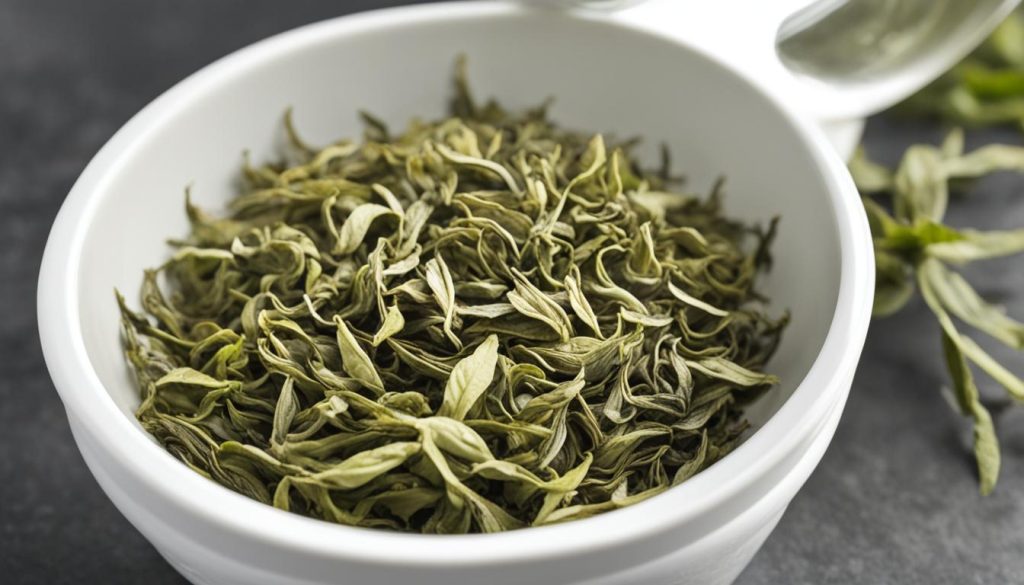
How to Brew White Tea: Steeping Time
When it comes to brewing white tea, the steeping time plays a crucial role in extracting the perfect flavors and ensuring a delightful tea-drinking experience. The steeping time can vary depending on the specific type of white tea and personal preference. Here is a guide to help you steep white tea to perfection.
First Steeping
For the first steeping of white tea, it is generally recommended to steep it for a range of 5 to 8 minutes. This allows the delicate flavors to infuse into the water, creating a harmonious and balanced cup of tea. However, specialty brands may suggest longer steeping times, such as up to 15 minutes for certain varieties like Silver Needles. If you prefer a stronger tea, you can increase the steeping time to suit your taste.
Additional Steepings
White tea leaves can often be steeped multiple times, each infusion offering a unique flavor profile. To get the most out of your white tea, you can adjust the steeping time for each subsequent cup. Add 2 to 3 minutes to the steeping time with each additional steeping. This gradual increase in steeping time allows the flavors to evolve and deepen, creating a layered and satisfying tea experience.
Remember to taste the tea after each steeping to determine the preferred flavor intensity. Depending on your taste preferences, you can continue steeping the white tea for additional rounds until the desired flavor is achieved.
Now that you know the importance of steeping time, let’s explore the other essential aspects of brewing white tea to elevate your tea-drinking journey.
Pre-Warming Your Teacups
Enhance your tea drinking experience by pre-warming your teacups. This simple step ensures that your tea maintains its temperature and enhances the overall flavor and aroma. Here’s how:
- Boil water: Start by boiling water in a kettle or pot.
- Pour into teacups: Carefully pour a small amount of boiling water into each teacup, filling them about one-third of the way.
- Swirl and discard: Gently swirl the boiling water inside the teacups, distributing heat evenly. Then, discard the water.
- Brew your tea: Once your teacups are pre-warmed, proceed to brew your white tea using the proper water temperature and steeping techniques.
By pre-warming your teacups, you eliminate any temperature shock when pouring in your brewed white tea. This helps to maintain the optimal tea temperature, ensuring an enjoyable and consistent tea drinking experience throughout.
| Benefits of Pre-Warming Teacups: |
|---|
| Enhances the flavor and aroma of the tea |
| Maintains the temperature of the tea |
| Creates a soothing and enjoyable tea-drinking experience |
Why Pre-Warming Teacups Matters
Pre-warming your teacups is important because it helps to maintain the ideal temperature of your brewed white tea. When tea is poured into a cold cup, it can rapidly lose heat, resulting in a suboptimal drinking experience. By pre-warming your teacups, you ensure that each sip of your tea carries the intended flavors and stays warm until the last drop.
Health Benefits of White Tea
White tea offers a range of health benefits, thanks to its high concentration of antioxidants and lower caffeine levels compared to other teas. Let’s explore some of the potential health effects of this delightful beverage:
1. Antioxidant Powerhouse
White tea is packed with antioxidants that help combat free radicals in the body. These powerful compounds, such as catechins and polyphenols, protect cells from oxidative stress and may reduce the risk of chronic diseases.
2. Cardiovascular Health
Studies suggest that the antioxidants found in white tea may help improve cardiovascular health. They may help lower blood pressure, reduce bad cholesterol levels, and promote healthy blood vessel function, reducing the risk of heart disease.
3. Boosted Immunity
The immune-boosting properties of white tea can be attributed to its high levels of antioxidants and catechins. These compounds may help strengthen the immune system, supporting overall health and reducing the risk of infections.
4. Skin Health
The antioxidants in white tea can also benefit your skin. They help protect against skin damage caused by harmful UV rays and environmental pollutants, potentially reducing the signs of aging and promoting a more youthful appearance.
5. Weight Management
Drinking white tea as part of a balanced diet and exercise routine may aid in weight management. Some research suggests that white tea can increase fat oxidation and boost metabolism, assisting in maintaining a healthy weight.
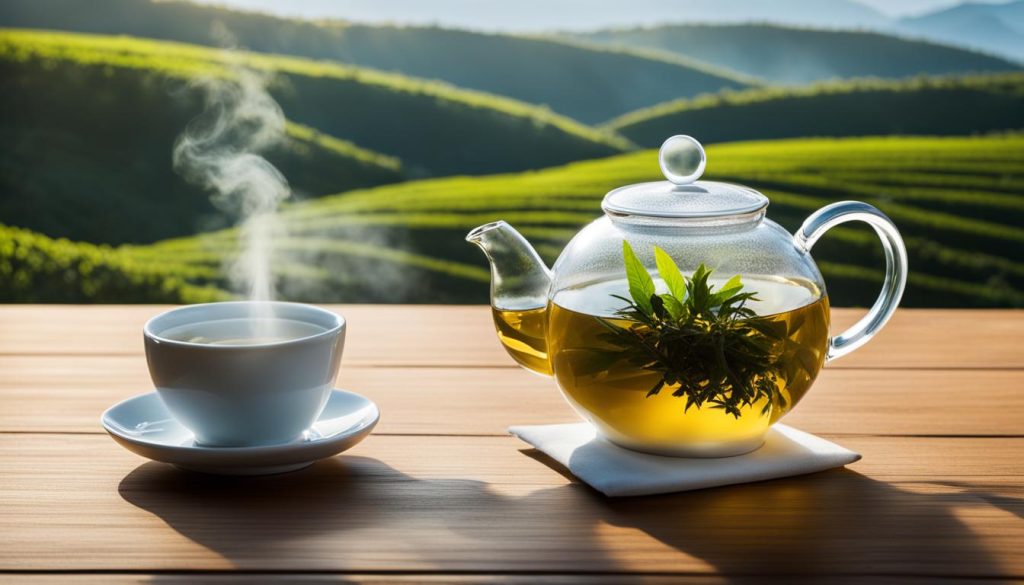
While these potential health effects are promising, it’s important to note that more research is needed to fully understand the extent of white tea’s benefits. Incorporating white tea into your daily routine can be a delicious way to support your overall well-being.
White Tea as a Special Occasion Tea
White tea is truly a special occasion tea, with limited production and a reputation for its exquisite flavor and delicate characteristics. Its refined qualities make it a sought-after choice for tea enthusiasts and a delightful addition to any tea ceremony. Whether enjoyed on its own or paired with light and elegant food, white tea offers a unique and enjoyable tea-drinking experience.
One of the reasons that white tea is considered a luxurious treat is its limited production. Unlike other types of tea that are more widely available, white tea is made from the youngest and most delicate leaves and buds, meticulously harvested by hand. This labor-intensive process contributes to its higher price tag but also ensures the exceptional quality that white tea is known for.
With white tea’s limited production comes a high demand among tea connoisseurs. The popularity of white tea continues to grow as more people discover its fine flavor and delicate nuances. The demand for this special tea makes it an excellent choice for special occasions, allowing you to share a rare and delightful experience with friends and loved ones.
When it comes to tasting white tea, its clean and naturally sweet flavor takes center stage. The subtlety of white tea allows you to appreciate its gentle notes, from floral and fruity to nutty and honey-like undertones. The complex flavors and delicate aroma of white tea create a refined drinking experience that is truly unforgettable.
White tea’s light and smooth character, combined with its high concentration of antioxidants, makes it a healthy choice as well. This rare tea offers a delightful way to enjoy the health benefits provided by its natural antioxidants and lower caffeine levels.
As you indulge in a cup of white tea, take the time to savor each sip and appreciate the craftsmanship that goes into creating such a special brew. Enjoy its exquisite flavor and let it transport your senses to a world of refinement and elegance.
White Tea Comparisons
| White Tea Type | Origin | Flavor Profile | Caffeine Level |
|---|---|---|---|
| Silver Needle | Fujian, China | Delicately sweet and floral | Low |
| White Peony | Fujian, China | Subtle, slightly stronger flavor | Low |
| Tribute Eyebrow | Fujian, China | Mild, smooth, with a hint of nuts | Low |
| Long Life Eyebrow | Fujian, China | Floral and honey-like | Low |
| Darjeeling White | Darjeeling, India | Complex, muscatel flavor | Low |
Conclusion
In conclusion, mastering the art of steeping white tea is essential to experience its delicate flavors to the fullest. By following the recommended brewing techniques, you can ensure a perfect cup of white tea every time.
First, pay attention to the water temperature. Avoid using boiling water, as it can overpower the subtle flavors of white tea. Instead, aim for an ideal temperature range of 170 to 185°F (76 to 85°C) for optimal enjoyment.
Next, consider the tea-to-water ratio. Due to the less dense nature of white tea leaves, it is recommended to use a slightly higher amount of tea leaves compared to other teas. Adjust the quantity based on your personal taste preferences.
Steeping time is another crucial factor. The recommended range for the first steeping is 5 to 8 minutes, but feel free to experiment based on the specific type of white tea and your desired flavor intensity. For subsequent steepings, increase the steeping time slightly with each cup to extract the tea’s full range of flavors.
Last but not least, pre-warming your teacups before pouring in the brewed tea is a simple yet effective practice. This helps maintain the temperature and preserve the delicate aroma of white tea.
By following these white tea steeping tips, you can unlock the nuances and enjoy the flavors of this exquisite tea variety. Whether you prefer the delicate sweetness of Silver Needle or the slightly stronger notes of White Peony, white tea offers a wide range of flavor profiles to explore and savor.
